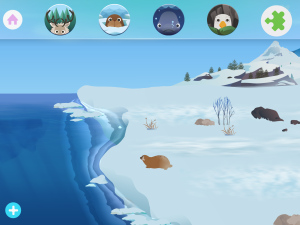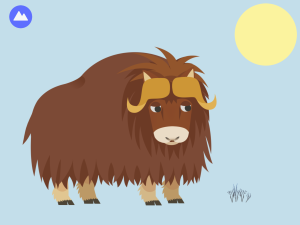2018 School Spending Survey Report

Find more great Horn Book content at these links:
Recommended books: reviews and themed booklists
App and e-book reviews
Movie reviews
Event news and recaps
Events calendar
MarcoPolo Arctic app review
On the opening screen of MarcoPolo Arctic (MarcoPolo, August 2015; iOS only), a polar bear and cub nap on the ice, a horned, green creature lying directly across from the pair with a camera.
 On the opening screen of MarcoPolo Arctic (MarcoPolo, August 2015; iOS only), a polar bear and cub nap on the ice, a horned, green creature lying directly across from the pair with a camera. The arctic is represented in white and shades of blue, with a cartoon-like, 2D style reminiscent of cut-paper collage. Hit the play button and the green creature snaps a picture, waking the sleeping pair of bears.
On the opening screen of MarcoPolo Arctic (MarcoPolo, August 2015; iOS only), a polar bear and cub nap on the ice, a horned, green creature lying directly across from the pair with a camera. The arctic is represented in white and shades of blue, with a cartoon-like, 2D style reminiscent of cut-paper collage. Hit the play button and the green creature snaps a picture, waking the sleeping pair of bears.The next screen shows ocean to the left with animals swimming or climbing in and out of the water. Coast to the right becomes forest as the player scrolls further along. Soft, gentle music plays and the colors used (now with a bit of green thrown in) are soothing and friendly. Rabbits hop between trees, arctic foxes prance prettily, and polar bears amble along the coast.
Along the top of the screen lie four circles, a different arctic animal in each. Along the bottom, the player can scroll through an assortment of arctic animals, food for the animals (including a glass of water), and — inexplicably — a beach ball, snowball, and a snow tractor. On this page, the player can interact with the animals by adding new animals to the mix, feeding them, or, I guess, throwing a beach ball at them.

When the bubble featuring the caribou is tapped, the player is brought to a page with a number of new animals (arctic land animals) and a woman’s voice gives a bit of brief information. Next, the player is invited to “build a caribou.” When the body shapes are placed on the correct spot, a pleasant popping noise shows that the task was done correctly; conversely, if a part is placed in the wrong space, there is a honking noise. If a significant amount of time lapses between the body part appearing and the player attaching it to the animal, the space flashes.
Facts about the featured animal are given as the body parts are placed (i.e., "Caribou release a scent from their ankles to warn other caribou of danger"). Body parts are sometimes named as they are placed, sometimes not. When the task is complete, the player can choose to build again or move on to the next task…which is building another arctic land animal.

After three land animals (caribou, musk ox, and a wolverine) are built, the user is instructed to place the animals in designated places in their habitat. As each animal clicks into place, the narrator names it, occasionally giving a fact about the animal, and it then does something cute. Back at the landscape on the main screen, one of the animals you've just built is delivered via helium balloons.
This process can be repeated three more times with other groupings of animals (land/sea animals such as seals, marine mammals, and migratory birds) until the player has been taught some facts about a few animals — for example, most polar bear cubs are born as twins — and the names of all the animals that appear on the screen. Overall, Arctic is a simple shape matching game with a bit of experiential play mixed in, teaching young users about arctic habitats and the animals that live there in an engaging way.
Available for iPhone, iPad, and iPod touch (requires iOS 8.0 or later); $2.99. Recommended for primary users.
RELATED
RECOMMENDED
ALREADY A SUBSCRIBER? LOG IN
We are currently offering this content for free. Sign up now to activate your personal profile, where you can save articles for future viewing.







Add Comment :-
Comment Policy:
Comment should not be empty !!!